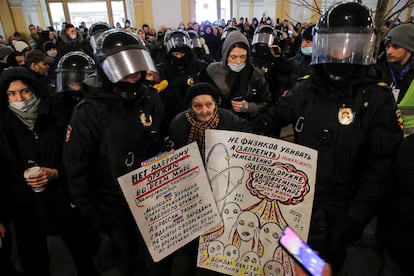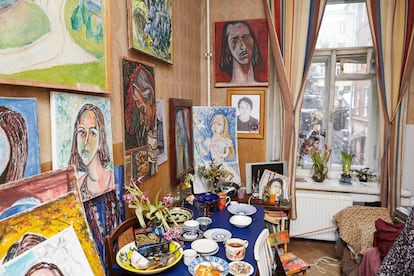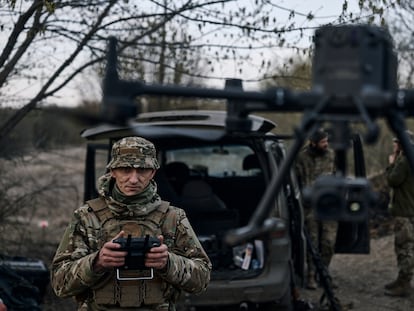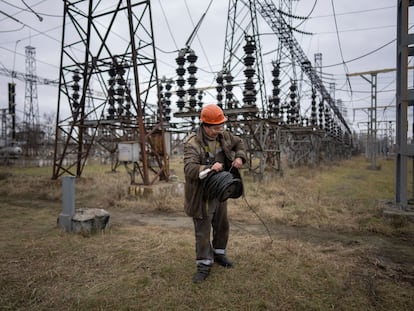Elena Osipova, the Russian artist opposing the war in Ukraine
Known as the conscience of St. Petersburg, the painter has been arrested multiple times for protesting against the Kremlin’s invasion. ‘This will end badly,’ she tells EL PAÍS from her modest apartment


In a corner of the dilapidated staircase below artist Elena Osipova’s modest apartment, a shelf holds a slice of bread next to the inscription: “No one forgotten, nothing forgotten. Here they sat during the blockade.” It’s a tribute to Osipova’s mother, who died during the Nazi’s deadly siege of St. Petersburg, which killed more than a million civilians during the Second World War. Osipova, a daughter of that war, is known today in her homeland as “the conscience of St. Petersburg.” She protested against Russian President Vladimir Putin for the first time in 2002. And two decades later, she continues speaking out. For her, staying silent is the most dangerous option of all. Her paintings keep alive the memory of victims: the dead and wounded from wars of recent years, and the casualties of other scourges, including the repression and drugs that claimed her son’s life and that of thousands of other Russians.
“Indifference, silence — that’s the most terrible thing that could happen. On a poster I wrote: ‘All of this happened because you stayed silent,’” says Osipova, from her komunalka — a communal apartment — where she has lived all her life. It’s a simple apartment; she shares the bathroom and kitchen with the other tenants. Her space is confined to two large rooms packed with dozens of paintings, a kind of museum that doesn’t appear in any St. Petersburg’s travel guides.
The police shut down her last exhibition, Peaceful Artistic Protest, a day after it opened in the local headquarters of the independent party Yabloko in early February. Security forces entered the headquarters to address an alleged bomb threat. Once in the gallery, the officers seized about two dozen works of art. “Images were found on the walls that possibly contain deliberately false information about Russian armed forces,” said the police report, which took as its basis Russia’s controversial law that criminalize any criticism of the Ukraine invasion.

“They promised that they will return the paintings in the summer or autumn,” says Osipova with a doubtful expression. As a precaution, the artist left some of her more overtly critical works out of the exhibition. These include a painting about the massacre in the Ukrainian city of Bucha and another work about the marines who were left to die on the sunken nuclear submarine Kursk in 2000.
When asked if she fears ending up in prison, Osipova replies: “Afraid of what?” She continues: “I have been to the police station, to trial, so many times… All I have left is that my granddaughter can live a normal life.” She recounts her innumerable encounters with the police and strangers who awaited her at her door to rip her posters out of her hands.
“Some provocateurs who said they support Putin came down the street. They threatened to take everything and call the police, but usually it’s the opposite. People support me, they say, ‘we’re with you,’” says Osipova. For now, the police tend to remove her from protests without further legal repercussions.
The artist caught the attention of the international press when police removed her from the first demonstrations against the war in Ukraine. But her activism goes back to 2002, when she first protested about the hostage crisis at Moscow’s Dubrovka Theater.
“I couldn’t stay silent. When Nord-Ost happened, the Chechen war, the drugs… I couldn’t stay silent,” Osipova says. Nord-Ost was the play in progress when a group of Chechen rebels stormed the Dubrovka theater. After several days of negotiations, security forces pumped gas into the theater. On an enormous canvas, she painted the spectators who died of asphyxiation and their kidnappers killed in the theater boxes.

“The opposition is in decline. People are fleeing, and there are fewer and fewer people who dare to go to the protests. There are good politicians who have stayed in Russia, but without the help of the people they can’t do anything,” Osipova says about the current situation in Russia. “This will end badly. There is the risk that what happened in the USSR will happen again. They sent critics to psychiatric hospitals to shut them up. Those times are returning.”
The artist lives on a monthly pension that was cut in half years ago without explanation. She receives 6,000 rubles, about €70 ($76) a month at the current exchange rate. “I’ve worked all my life as a teacher, as a painter, and it’s impossible to live on that pension,” she says. Despite her hardship, she welcomes visitors with a slice of potato frittata, herring, tea and a cake.
“Putin can do whatever he wants. He lies to pensioners and buys people with money,” the artist says, referring to the endless social programs approved since the war began. “Many go just to earn money,” she adds, explaining that the authorities “can’t find people who want to go [to the front]” but that the Russians “don’t have any money.” “They don’t have training. There’s no work to make a living. They live however they can, and so the government recruits a lot of young people. They don’t explain to them where they’re going or what they will face. Where they live, there is no work, just drugs.”
Drug addiction took the life of her 28-year-old son Ivan in 2009. One of the artist’s most sorrowful paintings shows the faces of five young people in red and blue tones, a mix of peace and sadness. “It’s called Our Children. I painted it in the 2000s. It reflects that era and the 1990s. They were friends of my son. All of them but the girl has died. They don’t exist anymore. They’re not in this world. And there were a lot of them. There were more like them in all the neighborhoods,” she sighs. Her husband, a well-known opposition artist, Guennadi Garvardt, died in the 1990s during a trip to Sweden in circumstances that were never clarified. The rumors about his death still distress her.
Opposition to the war
Tragedy has touched her whole family. One of Osipova’s grandfathers died of hunger during the siege of Leningrad. Her mother was saved in time. She enrolled in the army, where she met the artist’s father, who only saw her once, after the war ended.
Osipova detests war, but she returns to it in her work. She shows a sketch on a canvas: “These are invalids, people who have been left disabled by war. I call it Regret. There will be a whole series of combat victims, wounded, without legs, without arms.”
“They don’t show them on the news. They don’t talk about them, and that’s why people don’t understand what’s happening, why they don’t care,” Osipova adds.
The painter is pessimistic about the war in Ukraine. “It’s fine that [the West] wants to help in some way, but it’s dangerous and just gives this crazy man [Putin] more reasons [to act],” she says. She is fighting for peace, not against a specific government. She also demonstrated against the Iraq War at the United States consulate in 2003, as well as against diplomatic visits from countries with nuclear weapons.
But weapons of mass destruction may be her main political concern. “The first thing that should have been done when this war began was to demand that all countries come to an agreement about nuclear weapons,” she says.

The artist did not show her work until after she retired. “My favorite exhibition was in 2015, my first personal exhibition,” she recalls. “It was organized by Andrei Pivovarov. Now he’s in prison,” she says, mentioning the ex-director of the Open Russia foundation. He was sentenced to four years in prison in 2021 for supporting anti-government protests and for his involvement in an opposition platform that the Kremlin described as an “undesirable organization.”
“We have returned to the past. Exhibitions happen at home with people you know. If you want to do something daring, there could be problems. A portrait of Putin is simply impossible,” Osipova observes. She has never drawn the Russian president; she says it isn’t her style.
From her phone, she gets glimpses of the world of culture outside of propaganda-filled Russia. “The younger generations don’t see the best films. There is a lot they don’t know. We have to teach them. We have computers, you can choose whatever you want, but you have to get it right,” she says from behind her computer. A piece of tape covers the webcam. “They [the intelligence serve] listen in on the phones at any moment,” Osipova says. “I have close people in Ukraine, but we don’t talk about anything. It’s dangerous.”
Sign up for our weekly newsletter to get more English-language news coverage from EL PAÍS USA Edition
Tu suscripción se está usando en otro dispositivo
¿Quieres añadir otro usuario a tu suscripción?
Si continúas leyendo en este dispositivo, no se podrá leer en el otro.
FlechaTu suscripción se está usando en otro dispositivo y solo puedes acceder a EL PAÍS desde un dispositivo a la vez.
Si quieres compartir tu cuenta, cambia tu suscripción a la modalidad Premium, así podrás añadir otro usuario. Cada uno accederá con su propia cuenta de email, lo que os permitirá personalizar vuestra experiencia en EL PAÍS.
¿Tienes una suscripción de empresa? Accede aquí para contratar más cuentas.
En el caso de no saber quién está usando tu cuenta, te recomendamos cambiar tu contraseña aquí.
Si decides continuar compartiendo tu cuenta, este mensaje se mostrará en tu dispositivo y en el de la otra persona que está usando tu cuenta de forma indefinida, afectando a tu experiencia de lectura. Puedes consultar aquí los términos y condiciones de la suscripción digital.
More information
Últimas noticias
Aquilino Gonell, former Capitol sergeant: ‘If it hadn’t been for the police, the US would be a dictatorship’
A hybrid building: Soccer pitch, housing, and a shopping mall
Europe urges Trump to respect Greenland following annexation threats
Science seeks keys to human longevity in the genetic mixing of Brazilian supercentenarians
Most viewed
- Alain Aspect, Nobel laureate in physics: ‘Einstein was so smart that he would have had to recognize quantum entanglement’
- Mexico’s missing people crisis casts a shadow over World Cup venue
- Alvin Hellerstein, a 92-year-old judge appointed by Bill Clinton, to preside over Maduro’s trial in New York
- Why oil has been at the center of Venezuela-US conflicts for decades
- Cuba confirms death of 32 of its citizens in the US attack against Venezuela










































